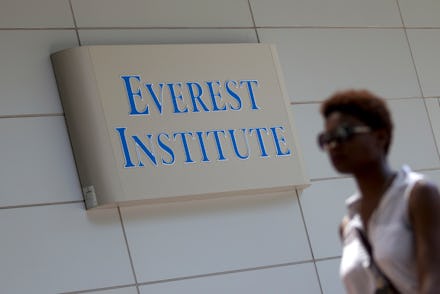One Statistic Sums Up Why For-Profit Colleges Are a Complete Disaster

In recent years, a number of major for-profit higher education chains have attracted a great deal of notoriety for scamming students and stranding them with mountains of debt. But for-profit higher education has been around for quite some time — since the birth of the republic in fact — so it might not seem quite fair to condemn the entire sector based on the ill-reputation of a few of the worst offenders.
But a new working paper from the National Bureau of Economic Research indicates that poor results at profit-driven schools is far from a case of a few bad apples. It appears to be a problem of rotten orchards.
As the Washington Post reports, the study, which analyzed the employment and earnings of 1.4 million students using data from Department of Education and the IRS, found that students who pursue vocational certificates at for-profit colleges make an average of $900 less a year than they did before their attendance.
By contrast, students who went after the same certifications at community colleges — which are public, and much less expensive — made $1,500 more annually than before their attendance.
Read more: 4 Ways For-Profit Universities Have Ruined People's Lives
Behind the numbers: Why are students who attended for-profit colleges to acquire new skills and knowledge in fields like nursing and auto repair worse off than they were before they had them? The study isn't able to determine that.
Since the study lines up demographically similar students, the answer is unlikely to be found in the kind of individuals who opt for for-profits instead of community colleges.
Instead, it could possibly have to do with the way employers react to certain kind of credentials from for-profit schools. The negative effects that for-profit students experience "are largely generated by the high proportion of students do not complete their program of study," given that people who do complete their for-profit certification programs do see a modest boost in earnings. In other words, being a for-profit program dropout might be a stain on one's credibility as they pursue new jobs.
"It could possibly be a negative signal," Stephanie Cellini, a professor at George Washington University and one of the authors of the study, said in an interview.
Students drop out of community colleges at higher rates than for-profit students, but those who do so still experience positive earnings outcomes on average.
There is also the possibility that students of for-profit colleges suffer from unrealistic expectations about the effect of their for-profit program coursework, and end up enduring lower wages as they switch to the sector they thought their education would help them advance within. With so many for-profit programs in disrepute, it's quite likely that employers are unlikely to provide workers with higher wages for them.
While the reason that for-profit school vocational program attendees tend to do so badly is a bit of a mystery, it is crystal clear that they aren't delivering on what they promise their students. And that's not even taking into account the enormous debt they heap on students.
According to the study, 83% of for-profit students in vocational certification programs take out loans, while less than a quarter of community college certificate students do. For-profit students had an average of $5,300 worth of debt. Community college students? $1,300.
For-profit higher education could theoretically consist of sophisticated institutions that provide students with a quality education. But most evidence at the moment suggests that they leave students worse off than when they began, and that any enrichment they offer is for their shareholders.